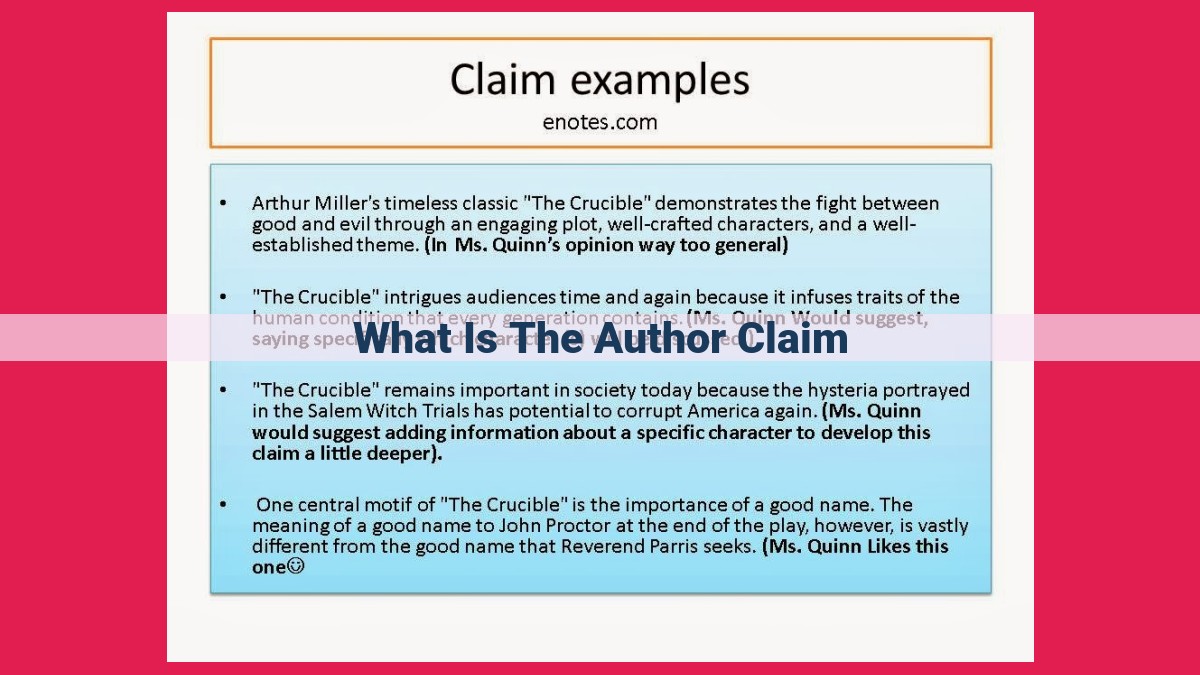Identify The Author’s Claim: Essential Guide For Understanding Textual Argumentation

The author’s claim is the main stance or argument presented in a text. It is crucial to identify the claim to understand the author’s perspective and follow the logical flow of the writing. The claim may be explicitly stated in a thesis statement or subtly inferred from the context. Related concepts include counterarguments, which challenge the claim, and rebuttals, which defend it. By reading the introductory paragraph, analyzing sentences expressing opinions, and determining the primary idea presented, readers can effectively identify the author’s claim.
Embark on a Literary Adventure: Unraveling Author’s Claims
In the vast literary landscapes, authors often present their persuasive ideas through a powerful tool known as the author’s claim. Understanding and identifying this claim is pivotal in navigating the labyrinth of complex texts.
The Essence of an Author’s Claim
An author’s claim is the central argument or stance that the writer presents and strives to prove throughout a text. It is the compass that guides the reader through the author’s perspective and the foundation upon which the entire narrative or argument rests. Claims can vary in nature, from asserting a specific point of view to advocating for a particular action.
The Significance of Identifying the Claim
Identifying the author’s claim is crucial for several reasons. Primarily, it provides a clear understanding of the main stance presented in the text. Without this knowledge, readers may find themselves lost in a sea of information, unable to distinguish the author’s central argument from supporting points or tangential digressions. Furthermore, comprehending the claim enables readers to:
- Engage in meaningful discussions and debates
- Critically evaluate the author’s arguments
- Develop informed opinions on the topic presented
Related Concepts in Claim Analysis
- Thesis statement as an explicit expression of the claim
- Counterarguments: Opposing viewpoints challenging the claim
- Rebuttals: Author’s defense against counterarguments
Related Concepts in Claim Analysis
Understanding an author’s claim is crucial when analyzing an argument. However, there are other related concepts that play a significant role in the process.
One essential concept is the thesis statement. This is the explicit expression of an author’s claim. It usually appears in the introduction of a text and concisely states the main argument. Identifying the thesis statement provides a clear understanding of the author’s position on the topic.
Another important concept is counterarguments. These are opposing viewpoints or objections to an author’s claim. They can be presented by the author themselves to acknowledge potential objections or they may be presented by others in a debate or discussion. Counterarguments challenge the validity of the claim and require the author to defend their stance.
Finally, we have rebuttals. These are responses from the author to address the counterarguments raised. Rebuttals aim to refute or weaken the opposing viewpoints by providing evidence, logical reasoning, or alternative perspectives. Through rebuttals, authors demonstrate why their claim holds more weight than counterarguments.
By understanding these related concepts, readers can gain a comprehensive understanding of an author’s argument. They can identify the main claim, recognize opposing viewpoints, and assess the author’s defense against these challenges. This deeper analysis allows readers to critically evaluate the validity and strength of the argument being presented.
The Art of Unveiling an Author’s Claim: A Guide to Masterful Identification
Steps for Identifying an Author’s Claim
When delving into the depths of a text, discerning the author’s claim is like discovering the hidden treasure trove of their argument. Follow these steps to become an intrepid claim seeker:
1. Embark on an Introductory Journey
Glide through the introductory paragraph, akin to a seasoned explorer navigating uncharted waters. Within these opening sentences, the author often drops tantalizing hints about their main stance. Look for key phrases or strong opinions that set the tone for their argument.
2. Unearth the Treasure of Clear Opinions
Your eyes become your archaeological tools as you comb through the text, seeking sentences that express unequivocal opinions. These gems are like buried artifacts, revealing the author’s perspective. Mark them down, as they hold the potential to unlock the elusive claim.
3. Discern the Primary Argument’s Radiance
With your archaeological toolkit in hand, you embark on the final step: determining the primary idea or central argument presented in the text. This pivotal claim is the foundation upon which the author’s arguments and evidence are built. It is the essence of their message, waiting to be unearthed.